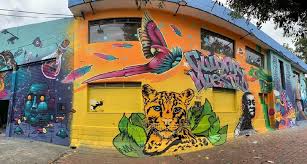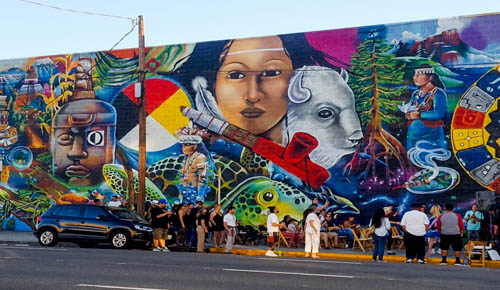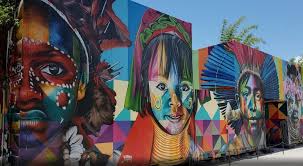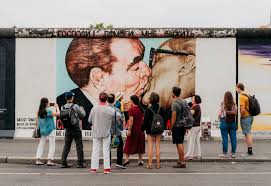Introduction: From Subculture to Global Cultural Phenomenon

This Website Was Written and Sponsored by Login Paus Slot
The journey of street art from the fringes of illegality to the pinnacles of the global art world represents one of the most significant cultural shifts of the past half-century. This vibrant and often disruptive form of expression has fundamentally altered our visual landscape, challenging entrenched notions of art, public space, and ownership. The street art cultural impact is not confined to the painted walls themselves; it reverberates through our economies, our social dialogues, and our very understanding of urban identity. This article delves deep into the multifaceted ways street art has reshaped contemporary culture, moving beyond its aesthetic appeal to examine its role as a powerful social and economic force. The street art cultural impact is a story of democratization, rebellion, and ultimately, profound transformation.
For decades, the dominant narrative framed street art and graffiti as mere vandalism—a symptom of urban decay and social disorder. However, a paradigm shift has occurred. What was once scrubbed away by city authorities is now often curated, celebrated, and protected. This re-evaluation is at the heart of the modern street art cultural impact. It forces us to question: who gets to decide what is art and where it belongs? By taking art out of the exclusive halls of museums and galleries and placing it directly into the public realm, street art has democratized artistic consumption, making it accessible to everyone, regardless of their background or socioeconomic status. This accessibility is a cornerstone of its powerful street art cultural impact.
The influence of this movement is now undeniable. It has revitalized derelict neighborhoods, sparked important global conversations on pressing issues, and created a new, lucrative market within the art world. The street art cultural impact can be seen in advertising, fashion, and design, where the aesthetic of the street has been eagerly co-opted by mainstream commerce. To fully appreciate the depth of this phenomenon, we must explore its various dimensions, from its role in urban renewal and tourism to its function as a tool for social commentary and its complex relationship with the art establishment. The ongoing street art cultural impact continues to evolve, challenging and enriching our world in equal measure.
Redefining Public Space and Artistic Accessibility
One of the most fundamental aspects of the street art cultural impact is its radical redefinition of public space. Traditional public art, such as commissioned statues and fountains, often represents official histories and power structures. Street art, by contrast, is inherently democratic and often subversive. It transforms blank walls, alleyways, and infrastructure into a canvas for the people, creating an open-air gallery that is free to access and constantly changing. This act reclaims the urban environment from corporate and municipal control, injecting it with the voices, concerns, and creativity of the community. The street art cultural impact lies in this power shift, making the city a site for ongoing, unrestricted dialogue.
This accessibility breaks down the formidable barriers that often surround the traditional art world. Museums and galleries can be intimidating, expensive, and geographically limited. Street art, however, encounters people during their daily routines—on their way to work, school, or the market. This involuntary encounter is a key element of its street art cultural impact. It forces a engagement with art outside a formal setting, provoking thought and emotion in an unexpected context. A powerful mural about social justice in a neglected neighborhood can have a far deeper resonance than a similar theme presented in a sterile gallery, demonstrating the unique potency of the street art cultural impact in reaching a broad and diverse audience.
Furthermore, this transformation of public space fosters a unique sense of place and local identity. Neighborhoods known for their vibrant street art scenes, such as Bushwick in New York or Wynwood in Miami, develop a distinct cultural fingerprint. The art on the walls becomes part of the community’s story, reflecting its character, struggles, and aspirations. This creates a more human-centric and engaging urban experience, turning monotonous concrete jungles into dynamic, walkable environments filled with discovery. The street art cultural impact is, therefore, deeply tied to urban psychology, making cities feel more creative, alive, and personally connected to their inhabitants.
The Catalyst for Urban Regeneration and Tourism

A highly visible and economically significant street art cultural impact is its role as a catalyst for urban regeneration. Cities worldwide have witnessed how strategic street art can breathe new life into dilapidated and neglected areas. The transformation of the Wynwood Walls district in Miami is a prime example. What was once a collection of deserted warehouses is now a world-renowned destination, attracting millions of visitors and generating substantial revenue. This model has been replicated globally, from the laneways of Melbourne to the streets of Lisbon, proving the powerful street art cultural impact on urban economics and development.
This process, often called “touristification,” begins when artists are drawn to the low rents and abundant wall space of industrial or economically depressed zones. As their work accumulates, the area gains a reputation for creativity and edginess, attracting visitors, cafes, and small businesses. This influx of foot traffic and capital can lead to significant neighborhood revitalization. The street art cultural impact here is dual-edged: it can improve the physical environment, reduce crime perception through increased “eyes on the street,” and create new economic opportunities for local residents. This tangible benefit has led many city governments to shift from criminalization to commissioning street art.
However, this economic street art cultural impact is not without its controversies. The very success of an art-led regeneration often leads to gentrification. As a neighborhood becomes more attractive and fashionable, property values and rents rise, potentially displacing the original residents and artists who made the area desirable in the first place. This creates a paradox where the organic, grassroots culture is priced out by its own success. The street art cultural impact in this context becomes a complex narrative of both creation and displacement, forcing a critical examination of how art, capital, and community intersect in the modern city.
A Powerful Megaphone for Social and Political Discourse
Perhaps the most potent street art cultural impact is its function as an unfiltered platform for social and political discourse. Operating outside traditional media and institutional frameworks, street art provides a voice for the marginalized and a tool for activists. It can distill complex issues into a single, powerful image that is instantly understandable and shareable in the age of social media. The street art cultural impact as a form of protest and commentary is immense, turning city walls into newspapers, manifestos, and memorials for the public.
Globally, street art has been at the forefront of revolutionary movements and social campaigns. During the Arab Spring, walls in Cairo and Tunis became canvases for expressions of dissent and hope. The work of artists like Banksy, with his sharp satirical pieces on war, consumerism, and surveillance, sparks international conversation. Similarly, Shepard Fairey’s “Hope” poster for Barack Obama’s campaign demonstrated how the aesthetic of street art could be harnessed for a mainstream political message, showing the vast reach of its street art cultural impact. These works serve as a public barometer, visually documenting the anxieties, anger, and aspirations of a society.
On a local level, the street art cultural impact is equally profound. Community-led murals can address hyper-local issues such as gentrification, police violence, environmental justice, and cultural heritage. A mural celebrating the history of a Latino neighborhood, for instance, becomes an act of cultural preservation and resistance against erasure. By giving visual form to these struggles, street art ensures that certain stories are not forgotten. It empowers communities to tell their own narratives, creating a people’s history that is permanently inscribed, yet dynamically changing, on the urban canvas. This grassroots-level street art cultural impact is vital for fostering a sense of agency and identity.
The Mainstream Embrace and Commercial Co-option
The journey of street art into the heart of mainstream culture is a central chapter in the story of its street art cultural impact. The aesthetic, once considered rebellious and underground, is now ubiquitous in advertising, fashion, graphic design, and entertainment. Major brands eagerly collaborate with famous street artists to appear cool, authentic, and edgy to younger consumers. This commercial adoption is a clear indicator of the movement’s significant street art cultural impact, signifying that its visual language now holds considerable cultural and economic capital.
This embrace extends into the traditional art establishment. Auction houses like Sotheby’s and Christie’s now regularly sell works by street artists for record-breaking sums, while major museums host retrospectives. The phenomenon of Banksy, an artist who maintains anonymity while achieving global superstardom, epitomizes this paradoxical integration. His spontaneous shredding of his own painting at an auction was a stunning critique of the art market, yet it simultaneously increased the work’s value and fame—a perfect illustration of the complex street art cultural impact within commercial systems. This event highlighted the ongoing tension between street art’s anti-establishment roots and its newfound status as a blue-chip asset.
This process of co-option is a double-edged sword, and its street art cultural impact is debated intensely within the community. On one hand, it provides artists with financial stability and a global platform, allowing them to reach audiences far beyond the street. On the other hand, it risks diluting the art form’s subversive power and authentic voice. When a style born from rebellion is used to sell sneakers or luxury handbags, does it lose its critical edge? This tension is an inherent part of the street art cultural impact, reflecting a constant negotiation between authenticity and commercial success, between counter-culture and mainstream acceptance.
Challenging Legal and Ethical Norms of Public Space

The very existence of street art forces a continuous and necessary public conversation about legality, property, and the ethics of public space. This legal and philosophical street art cultural impact is fundamental to its nature. The core act of creating unsanctioned art on someone else’s property is, by definition, vandalism. This challenges the Western concept of private property as sacrosanct and raises profound questions: who truly owns the visual field of the city? Is a blank wall a private asset or a potential public resource? The street art cultural impact lies in its ability to make these abstract questions urgent and visible.
The response from authorities and communities has evolved, creating a complex legal landscape that is part of the ongoing street art cultural impact. While punitive measures remain, many cities have developed “legal wall” programs, mural festivals, and commissioning processes that legitimize the art form. This shift from criminalization to curation represents a significant cultural victory for the movement. It acknowledges that the value of this cultural expression can, in certain contexts, outweigh the violation of property rights. This evolving legal framework is a direct result of the persistent street art cultural impact on public opinion and urban policy.
Ethically, the conversation is equally nuanced. The street art cultural impact includes debates about the preservation of ephemeral art. Is it right to remove a wall, as has been done with some Banksy pieces, to sell it for profit, effectively decontextualizing the work from its community? Furthermore, what are the ethics of gentrification driven by art? These dilemmas have no easy answers, but they are essential discussions prompted by the proliferation of street art. The street art cultural impact thus extends beyond the visual, challenging us to constantly re-evaluate our legal and ethical frameworks concerning creativity, ownership, and the collective right to the city.
Fostering Community Identity and Collective Expression
At its most positive, the street art cultural impact is deeply communal, fostering a strengthened sense of local identity and facilitating collective expression. Unlike a painting in a private home, a public mural is a shared possession. It becomes a landmark, a point of pride, and a symbol of collective identity for the people who live alongside it. This aspect of the street art cultural impact is particularly powerful in diverse or underserved communities, where public art can visually articulate a shared history or common aspirations that might otherwise go unspoken.
Community mural projects are a clear manifestation of this positive street art cultural impact. These initiatives often involve local residents in the creative process, from conceptualization to execution. This collaborative approach ensures that the final artwork truly reflects the community’s voice rather than just the artist’s individual perspective. The process itself builds social capital, strengthens community bonds, and provides skills and empowerment to participants. The resulting mural is not just a decoration; it is a testament to the community’s ability to shape its own environment, a lasting reminder of its agency and creativity.
This collective aspect of the street art cultural impact also serves an educational function. Murals can depict local history, celebrate cultural heroes, or illustrate ecological principles specific to the area. For children growing up in these neighborhoods, this art provides a constant, accessible source of cultural education and inspiration. It normalizes creativity and demonstrates that art is not a remote activity for the elite but a vital part of everyday life. This nurturing of local culture and identity is one of the most sustainable and meaningful forms of street art cultural impact, creating a legacy that is felt by residents long after the tourists have left.
The Influence on Contemporary Art and Design Aesthetics
The stylistic street art cultural impact on contemporary art and design is immeasurable. The visual language developed on the streets—stenciling, bold graphic lettering, vibrant color palettes, and a dynamic sense of composition—has been thoroughly absorbed into the mainstream. Contemporary painters, illustrators, and graphic designers openly borrow from the techniques and aesthetics pioneered by street artists. This cross-pollination is a clear sign of a profound street art cultural impact, blurring the lines between “high” and “low” art and enriching the visual vocabulary of our time.
In the world of design, the street art cultural impact is everywhere. It is seen in the distressed textures of fashion garments, the bold typography on album covers and posters, and the gritty, urban feel of video games and film sets. The “DIY” ethic and the embrace of imperfection that characterize much of street art have provided a welcome antidote to the sterile perfection of digital design. This aesthetic influence is a key component of the street art cultural impact, proving that the movement’s innovations are not confined to outdoor walls but have permeated the very fabric of our visual culture.
Furthermore, street art has challenged the very definition of the “artist.” It introduced the idea of the artist as a provocateur, an activist, or an anonymous phantom, moving away from the romantic ideal of the solitary genius in a studio. The street art cultural impact has expanded the artist’s toolkit to include spray cans, wheatpaste, stencils, and even tile mosaics, legitimizing these as serious artistic mediums. By prioritizing concept and context over medium and tradition, street art has broadened the horizons of what is considered art, leaving an indelible mark on the philosophy and practice of contemporary creativity. This conceptual street art cultural impact may be its most enduring legacy.
Conclusion: An Enduring and Evolving Cultural Legacy
The street art cultural impact is a multifaceted and ongoing phenomenon that has irrevocably altered our world. It has transformed our cities from monotonous landscapes into dynamic, open-air galleries, fostering a more democratic and accessible relationship with art. The street art cultural impact is evident in the economic revitalization of neighborhoods, the global conversations it sparks on social justice, and its deep influence on contemporary aesthetics. From a dismissed subculture, it has grown into a global force that challenges authority, inspires communities, and commands the attention of the art market.
However, this journey is not without its contradictions. The same art form that serves as a tool for anti-capitalist protest has become a valuable commodity. The communities that street art helps to revitalize can be displaced by the very growth it triggers. The ephemeral nature of the art form clashes with the desire to preserve culturally significant works. These tensions are not signs of failure but are inherent to a living, evolving cultural movement. They demonstrate that the street art cultural impact is complex, nuanced, and constantly being renegotiated.
As we look to the future, the street art cultural impact will undoubtedly continue to evolve. With the advent of new technologies like augmented reality and its continued role in giving voice to global issues, street art remains a vital and responsive form of cultural expression. Its greatest legacy is its demonstration that art is not a luxury but a necessity—a fundamental human impulse to comment, to beautify, and to connect. The walls of our cities will continue to talk, and the street art cultural impact will ensure that we are all compelled to listen, to look, and to engage with the world around us in new and profound ways.

